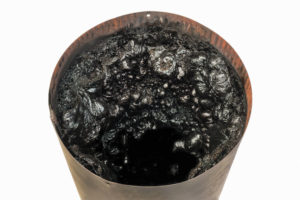 Creosote is a natural occurrence in the chimney system when organic fuels are burned. Byproducts of your wood, oil, or gas fire include vapors, smoke, tar, creosote, and soot. The combination of tar, creosote, and soot is a black residue often called creosote, and it can be extremely dangerous if left unchecked.
Creosote is a natural occurrence in the chimney system when organic fuels are burned. Byproducts of your wood, oil, or gas fire include vapors, smoke, tar, creosote, and soot. The combination of tar, creosote, and soot is a black residue often called creosote, and it can be extremely dangerous if left unchecked.
Creosote buildup occurs over time and can be avoided with regular maintenance such as chimney sweeps and inspections. When the creosote is not removed and is allowed to accumulate it can become a dangerous problem.
This process occurs in three stages:
- First Degree Creosote Buildup—this degree of creosote occurs under the best conditions for your chimney. It is mostly soot and can be removed effectively using standard chimney brushes. Your chimney sweep can accomplish this task during a routine chimney sweep appointment.
- Second Degree Creosote Buildup—this creosote buildup is less soot, and more shiny black flakes that can actually be flammable. While it isn’t as easy to remove with a simple brush, it IS removable. This type of creosote will occur if the incoming air is restricted, affecting the chimney’s draft, usually with wood stoves and fireplaces with glass doors.
- Third Degree Creosote Buildup—this stage of creosote buildup is considered a serious fire risk. It is often called glazed creosote because of it’s glossy, hard appearance. This creosote is primarily made up of tar and is therefore a highly concentrated fuel. As the fireplace and chimney are heated the glazed creosote heats and melts into a liquid-tar substance, and as it cools it returns to an even more concentrated state of glaze attached to the sides of the chimney flue. This glazed creosote can be gummy or hard and porous.
The type of glazed creosote that you have in your chimney flue will determine the way your chimney sweep removes it. When it is gummy the brushes and tools will not remove it. First your chimney sweep will apply a chemical compound that breaks down the glaze and leaves a flaky substance behind that can be brushed away. If the creosote is hard and porous your chimney sweep can use standard chimney brushes to remove the creosote.
Removing the Creosote Now
Creosote doesn’t reach the third degree of buildup overnight. Over time the creosote builds layer upon layer, becoming more of a danger by the day, especially if you use your fireplace daily. The best way to catch it and remove the creosote before it becomes an extreme risk is to keep up with your routine appointments. A certified chimney sweep can assess and remove the glazed creosote before your family is at risk. Even the most trained and experienced chimney sweep cannot keep your family safe from fire if you do not make your chimney appointments.
Call Chesapeake Chimney and let an expert assess and remove your creosote now.

Recent Comments